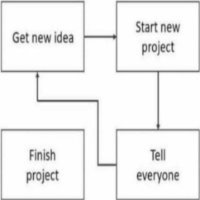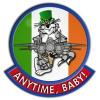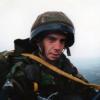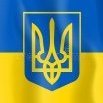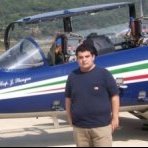Search the Community
Showing results for tags 'Tomcat'.
-
Finemolds is to release a 1/72nd Grumman F-14A Tomcat kit and a dedicated weapons set - ref. FP30 & FP-31 Release expected in December 2017. Source: http://www.finemolds.co.jp/iroiro/2017THS-new.html Reports as being the "Air Graphix/FineMolds" F-14D kit with changed parts: https://www.scalemates.com/kits/958331-finemolds-mg-789-2015-grumman-f-14d-tomcat V.P.
-

Great Wall Hobby 1/72 F-14A - Now Bandwagon 202
Jon020 posted a topic in Work in Progress - Aircraft
Having completed Hobbyboss and Academy’s 1/72 F-14As I thought that I probably knew enough about the aircraft layout to tackle one of the GWH kits that were sat leering at me from my stash. Just to recap – this was Tomcat No. 2 completed a couple of months ago Wichita 103 HIP killer by Jonathan Hughes, on Flickr Familiarity would be useful given the borderline ambiguity in the instructions (lots of it but with wrong parts called up and add-in correction pages strewn loose in the box), and there are lots of bits to manage. So, armed with a little confidence, I thought I set about this with the belief that despite its complexity that there wasn’t too much wrong with the kit. Right? Well, perhaps that’s not quite right but those encountered so far have been addressed. Tomcat project no. 3 by Jonathan Hughes, on Flickr On opening the box, one can’t fail to be surprised at the number of parts crammed into the box attached quite well onto 29 sprues.... that’s quite a lot for a 1/72 aircraft kit. The instructions are as vague and error strewn as expected but at least all parts are labelled with an alpha and numeric so you can find them easily on the right sprue... or can you? Why oh why are there 7 A sprues? Where’s the sense in that? Did they forget to change the alpha designator I wonder. As for subject, having completed a VF111 aircraft and a VF1, I thought I’d go for one of the other famous fighter squadrons and have opted for a VF84 aircraft; aircraft of other squadrons will follow... promise. However, as with my last model, I haven’t chosen one of the oft chosen schemes instead pluming for a 1988 rendition of the Squadron Commander’s aircraft BuNo 162702 which had the hi vis markings despite most other aircraft being quite plain at the time. The image that captured my attention is on page 226 of the kindle edition of Detail and Scale Colour and markings of U.S. Navy F-14 Tomcats Part 1 (Atlantic) by Bert Kinsey (may he get well soon). The photo (and I’ve found others since) shows the aircraft presumably returning from a gunnery training mission, with a training AIM-9 round, an ACMI pod and plenty of soot staining around the canon muzzle. So, other than a twin AIM-9 LAU-7 fit on the wing pylons, it should all be do-able. The tan colouring on the radome adds a nice splash of colour to the rather weary looking finish it exhibits. I’d acquired the kit about a year ago (or so)... it took a while to get to me from China... but that was in lockdown. It’s easier to come by now, but despite the time taken, the seller kept me informed with tracking info. I bought the Eduard sets (I’ll probably use some of the bits but probably far from all of them) and just before I started in earnest, the Quinta Studios 3D cockpit panel set. I’d been very impressed with how the transfers settled over the molded detail on the Academy kit but my friend Brian was experimenting with a few cockpit tubs from different manufacturers and found that the GWH transfers were not as refined as the Academy ones and didn’t settle as well... much thicker. So, the Quinta items were secured as a hopeful solution. On closer inspection of some of the main parts, the panel lines seem quite nice but there seems to be a molding issue (mold alignment?) on some parts. One easy to illustrate example is on the nose halves. Here the starboard side and you can see that I’ve started to try to clean it up with some 400 grit paper. More work was needed, progressing to finer and finer papers until it was polished smooth and just a little re-engraving needed. This is not so much of an issue on the other nose half as it lines up with the gun panels, but it’s also evident on the intake trunking and lower fuselage half – each was addressed as above. Some smaller parts (such as nose gear) also exhibited this and they needed cleaning up a little more carefully. A check of the other two I had in my stash showed one to be worse and one to be about the same. I’d expected a little better in the quality control – or alignment of molds. At least it’s fixable... but at the cost of this kit, I’d hoped for better. Molding lines. Hmmmmm by Jonathan Hughes, on Flickr Before starting, I’d noticed another builder tackling the kit, or a D model version of the kit, presented by rymulus. This identified that the RIO’s instrument panel and coaming were too narrow. So, this was the first thing I looked at, not really wishing to take the approach that rymulus has done with a complete scratch build of the panel (and you should see the rest of the detailing being undertaken – quite mind numbing and something my fingers and eyesight just couldn’t master) I set about to examine this and consider alternative options. As you can see here, the coming is narrow – the instrument panels on the outer edge should overlap those of the panels that are in front of the cockpit side panels... evident here is that they don’t – the whole thing is far too narrow. I suspect that if you had the canopy closed, it’d not matter too much. I’m doing mine open, or I’d hoped to... so, problem. Narrow RIO coaming by Jonathan Hughes, on Flickr Rymulus’s solution was to cut the coaming piece in half add 1mm in the middle and make a new IP. After some ferreting around I came up with an alternative approach. Some time ago I bought an Aires cockpit set for the Hasegawa kit (nope, not made that yet either), but it was damaged in transit, so the seller sent me another one. That was more damaged in transit and at that point we gave up. But, the RIO panel was fine (in each). I took a look to see if that would fit. The sills in the cockpit are a little narrower than the Hasegawa I guess, so some thinning of the edges was needed, but I did managed to see that this would fit. Will this work? Aires RIO coaming to the rescue. Pre fettling by Jonathan Hughes, on Flickr One other item that I needed to resolve was that of the facia. Here the Aires item (right) and GWH item (left) are compared... with the Quinta 3D print (sized for the GWH kit) part 25. RIO panel comparison. Quinta 3D print behind by Jonathan Hughes, on Flickr My solution was to file the face flush and cut up the Quinta part into three items, as I’ve shown here positioned on the Aires panel. With some paint and touching up. I hope it’ll work. It’s what I’ve decided upon at least. As the upper panel is larger (again), I’ll retain that and paint it carefully. 3D print cut up and positioned on fettled Aires item by Jonathan Hughes, on Flickr With the Aires item added and the coaming side panels now all glued in place (tamiya thin) and sanded flush, the rear bulkheads looked decidedly sparse, so I decided to add some finesse with some stretched sprue, plasticard, microstrip and lead wire... some filler and some artistic license. The Aires coaming was actually a little damaged; it’s handle on the top was cracked and didn’t take to prising into position, so a new one from plasticard and stretched sprue was made and added... and some further lead wire details added. Cockpit tub detailed by Jonathan Hughes, on Flickr I’d a pair of GWH detailed seats that I’d made for the Academy kit that I could use, as I fitted the Academy seats in the end, etched out a bit to take a pair of Reedoak figures, but I decided to keep them to go in the VF1 kit should I decide to display it sans crew at any point and went to use the Aires seats that had come in the Aires cockpit set (that was damaged)... seats were fine. Width wise these sit fine, although I added a plasticard spacer under each to rise them to the right height. Detailed tub with Aires seats by Jonathan Hughes, on Flickr And shown here inside the nose section for a dry-test fit Tub trial fit by Jonathan Hughes, on Flickr Two other items that need attention at this stage of the build are the nose gear bay, and the nose gear leg (which I put “mostly” together at the same time to check, check, check and recheck fit – to confirm that it will go in later in the build. It will. The gear bay has some detail, but as rymulus shows in that build, the nose gear bay is the wrong shape (!) and the detail is molded quite heavily and still relatively sparse. I thought I took more photos that I seem to have (at a time when time was limited due to other commitments so I just build some bits when I could) but I added some plasticard and microstrip and lead wire to the nose gear bay to fill it out a bit. I did the same to the nose leg, mainly to add pipework etc, but not too much. Important – the nose leg still fits in. Nose gear in bay test fit. Fettled and detailed (Eduard, microstrip and lead wire) by Jonathan Hughes, on Flickr The nose leg is shown here after some primer and paint was added. It’ll be cleaned up and sorted before going further. I’ve left the two side actuators off at present (are they kneeling actuators?) so that I can paint the oleo easier. I’ll add them later in the build... they’re attachment is quite large to shouldn’t pose a problem. I’d had to add them in the Academy kit as they’re missing (as is the retraction jack)... again not shown here, but is best to fit into the bay, fit the leg, then attach the jack to the leg. I’ve tried several options. Detailed nose leg painted white by Jonathan Hughes, on Flickr Right, so back to the build. RIO coaming – I’ve a plan. Good. Press-on. Fuselage halves and intakes are quite a complicated set of assemblies but go together quite well. Dry fit several times before committing to glue... noting that some parts are a little vague in placement in the instructions, that opened rear top of the intake rear behind the ramps, being one example. Oh, and the rear ramp too. Anyway, with some trial and error and patience, it can all be dry assembled, except the jack on the rear ramp, and test fitted. On inspection through all angles, it became evident that there is a gap that can just be seen through the intake where the fuselage upper half joins (or doesn’t quite) the lower half. Discovered intake gap by Jonathan Hughes, on Flickr On looking at photos, a PE piece would be ideal for this to depict the framing of the item that sits here neatly, but I decided to make a couple of small, thin, plasticard inserts to attach to the fuselage lower half, big enough to cover the gap. And these are shown here Intake gap solution by Jonathan Hughes, on Flickr Added bits, another view by Jonathan Hughes, on Flickr When the two halves are now brought together, the gap is hidden. Not perfect, but it’ll do Gaps hidden by Jonathan Hughes, on Flickr A little filler was added to hide the injection marks inside the intakes although I wasn’t sure these would be visible or not. The forward sparrow recesses have a large hole at the front of each, possibly to allow location of the phoenix pylons. Why these are fully molded as holes when all other holes need opening out, I don’t know... but I put a small piece of plasticard over the inside and filled these too. You may be able to see a little filler at the rear of the gun port cover. Hmmm another kit error to explain. Some filler needed by Jonathan Hughes, on Flickr The kit comes with a choice of two gun port options, an early and later A model version. But both parts have vents at the rear that only appeared very late on in production; the rear panel may have an access hatch but no vents. Wrong gun cover by Jonathan Hughes, on Flickr As filler would not take in the shallow cut outs and the overall panel was too recessed, I cut out the offending panel to a shallow depth and added a new thin piece of plasticard to replace it. Fixing the rear of the gun cover by Jonathan Hughes, on Flickr The plastic was thin so I cut out the shape of the access cover Access cover hole cut out by Jonathan Hughes, on Flickr And added a new part to fit within the hole. Not perfect, but it’ll do and it corrects another error ... hopefully I’ll not find (too m)any more. Panel complete by Jonathan Hughes, on Flickr Today, I pressed on with some paint after primer and first cover coats had dried (Mig one-shot) ... intakes and bits, in white... along with nose gear bay etc., all with Mission Models acrylic; cockpit tub was painted in a 70/30 mix of mission models Light Ghost Grey and Light Gull Grey in an attempt to match the Quinta Studios parts; some black added to the outer parts of the coamings (MM paints 70/30 mix of tire black and black) and details were then highlighted some details and painted detail parts (coaming fabric, seats, tub details) with Humbrol enamels as is my preference on small parts. First proper paint session by Jonathan Hughes, on Flickr So, in summary, at least I’ve started. At the moment, I have less time for modelling than at any point in the last few years so maybe I should have chosen a simpler kit. The kit complexities were known and I’d been advised of the need for plenty of test fits to ensure all is well before committing to glue. The parts’ fit is quite good... but a little vague in areas. The kit errors and quality of molding is a little annoying as I had expected a little more in terms of quality... but I will persevere with the hope that it will provide something that is worth the effort. Thanks for reading. Jon- 70 replies
-
- 13
-

-
https://www.facebook.com/story.php?story_fbid=pfbid035DVhVCpjGqVej8C3zZahR8Vt1GmvFm2LjLrtJVrmoT83GFRjCGANYoPQqxCdDkbEl&id=100091816387706&post_id=100091816387706_pfbid035DVhVCpjGqVej8C3zZahR8Vt1GmvFm2LjLrtJVrmoT83GFRjCGANYoPQqxCdDkbEl For the non Facebookers... As mentioned in the FB post, it seemed 'inspired' by a well known F-14 pic. Then stuff started jumping out at me.... Nose proportion and shape Colour scheme Intakes Bellytank Roostertail spacing Gun housing But most of all, the nose and the proportions.....I reckon the 'artist' modified an F-14 pic into an F-4! 🤣
-
I finished this model in August last year, and whilst I completed my work in progress thread, I didn’t get around to writing a RFI thread. Now that some months have elapsed and I’ve become accustomed to seeing the completed model (almost) every day on its “concrete” hardstanding base (scratch built), I think that I can reflect back on the build and bring out a few highlights. Yes, it took me about a year to complete, but that was because of other life pressures and the thinking and dithering time that ensued with my build. So, let’s get ion with it. In summary, this has to be the best-fitting F-14 Tomcat there is. The (2019 tool) Academy kit is also excellent, but there are some very clever assembly details with the FineMolds model that just helps produce a very robust end result. It has some wonderful details too; whilst some of these can appear a bit toy-like in their bare plastic, they look quite delightful once a few paint layers have been applied. Some details do warrant improving, and there’s plenty of aftermarket resin and PE available in this regard. In fact, with the details and assembly robustness, it should be the best 1/72 F-14 on the market… but for me, there was a serious let down which means that I could not hold it in such high regard - shape! Very early on, some shape discrepancies came to light. I will not list them all, as I’ve had to live with most of them but I did tackle two of them: Wings and wing-glove fairing. But before I go into these in detail, briefly the other items include the overall fuselage being too tall (especially around the nose and canopy), tail fins slightly disproportioned with fin “noses” too short, wing pylons oversized and ventral fins too short. All of these are subtle, but if you’ve built a cross section of the current 1/72 offerings as I have, the differences stand out. Don’t get me wrong, I’m quite satisfied by the finished article, but the shape issues are likely to prevent me making another of these in their present tooling. I imagine, that had I modelled it with all of the panels open and radome lifted (as you can choose to do), some of the shape issues might well be hidden, but personally, I found the choice of panels to open a little un-prototypical for anything other than on-maintenance… so then choosing to arm the aircraft would be just wrong. I did decide to open one panel, but this was based on observation of likely panels to be open when on the ramp… the refuel panel on the starboard side of the nose. There are no 1/72 kits on the marked that allow for this to be open, so my model is, in this regard at least, unique. I had a number of attempts at scratch building the inners of this panel and the door, the latter finally formed of a thin piece of plasticard with a shaped photoetch inner (to control the curvature easier), the former had a 1mm x 1mm neodymium magnet glued in as the fuel receptable; the scratch built fuelling hose attachment had a short length of steel pin inserted in the end to attach to the panel. Because I was opening this panel, I opted to open the refuelling probe too; photos tended to show this open when the refuelling panel was open… maybe it’s something to do with the fuelling process (I don’t know) but it looked good. Whilst lacking in a little detail, the attachment of this refuelling probe was by far the best I’ve seen on a kit in this scale, although I still needed to move the hoe that it plugs in to about 1.5mm aft to allow for correct placement. Other panels to open would be the “daily” panels on either side of the engine tunnels just aft of the main gear bays. These are something I’ll attempt on a future build, but again, no kits are available with these open in this scale today. What also put me off using the kit’s suggested open panels, were that the moulded panel doors were quite thick, and whilst the open spine details looked nice, the kit did not provide the removed panels to sit alongside the open bays whilst they were off (as most often seen in photos). So, the wings…. The kit wings are essentially too broad in chord. Whilst this possibly is liveable if these are all you’re comparing them with, put it alongside a Academy, GWH or Hobbyboss, and something will look odd. I covered this in a bit more detail in the early stages of my Work-In-Progress thread ... in fact it was the first thing I tackled. Taking the easy route initially, I detail-corrected and adjusted the “fit” of a pair of Hobbyboss wings to replace the FineMolds wings. Later, I decided to also modify the attachment of a pair of Fujimi kit wings. I quite fancied (again) a pair of dirty wings (slats and flaps only) rather than just the clean “sweep-able” Hobbyboss wings. I’d considered a pair of Hasegawa wings, but the Fujimi wings were more accurate and had a more adaptable “fit” for the FineMolds kit. One think that neither of the replacement wings (nor the FineMolds kit wings either) had, was the leading-edge anhedral crank at about 25% span; so far, only the 2019 tool Academy and GWH kits have this. So, nothing was going to be perfect. The wing glove fairings on the kit are a little too tall on their inboard edges (near the anti-slip panels) and present a too-straight upper surface when compared to actual photos and profiles. This was a relatively easy task to tackle, just by sanding back the top surfaces, flattening out the inboard-most edges and producing a more rounded profile than the kits parts. Once finished, the profile is better, but the overall shape of the glove fairing is still wrong, but much harder to rectify, so I left it as it was. My intention had initially been to portray VF84 Victory 201, BuNo 162702. Part way through my build the shape issues made me rethink this, and I decided for a more subtle scheme, picking VF11’s Ripper 101 (of which I found several photos online), using DXM’s excellent (double excellent in fact) decals. The decals did include a warthog face and tusks for each side of the nose, but given that this looked a bit comical and that I could find no photos of the aircraft carrying the markings, I left those off. The instructions in the decal set also showed an odd anti-glare panel demarcation, which made me wonder whether the aircraft had carried a completely different radome when those markings were carried; I wanted the nicely curved front to the anti-glare panel, so I felt my choice was vindicated. The other reason for picking VF11, was that having just finished my GWH build as a VF31 aircraft, the two would sit alongside each other well, both being Forrestal aircraft in the same period and having very close BuNos too 161858 (VF31) and 161855 (VF11)... practically twins! So, to summarise, I’ll not list out everything that I did to the kit, but the following image lists it all (I hope) out. Finemolds 1/72 F-14A detailed by Jonathan Hughes, on Flickr Origins by Jonathan Hughes, on Flickr Loaded up by Jonathan Hughes, on Flickr Back end by Jonathan Hughes, on Flickr Cockpit unmasking and checking by Jonathan Hughes, on Flickr Refueling hose connector by Jonathan Hughes, on Flickr Canopy by Jonathan Hughes, on Flickr Canopy underside by Jonathan Hughes, on Flickr Fuel hose test fit by Jonathan Hughes, on Flickr Ripper 101 from above by Jonathan Hughes, on Flickr Ripper 101 wings spread from above by Jonathan Hughes, on Flickr Ripper 101, Wings spread, Starboard rear by Jonathan Hughes, on Flickr Ripper 101 Starboard Profile by Jonathan Hughes, on Flickr Ripper 101 rear quarter by Jonathan Hughes, on Flickr Finally, before I go, I thought I’d just leave this final image for you to ponder. Having built the four “current” tool 1/72 Tomcats, I wanted to compare them shape wise, especially given my FineMolds experience. Initially, I set up a photo session, where I could place each model in the same orientation, with the nose wheel on the same spot on the level (x marks the spot) with my DSLR with it’s 100-400mm at 250mm focal length to minimise wide angle or tele-distortion and photographed each one. Initially, I overlaid each image atop each other, but that would be difficult to share, so I laid them out as shown. I shared this on a few Tomcat-focussed FB groups and received considerable interest and debate. I then acquired an early Grumman “blueprint” side elevation and overlaid that on each model (as shown). The line drawing lacked the spine strengthening strakes and vertical fin nose sections (because it was intended to depict the interior space on the centreline), but it illustrated the overall shape. I even had a comment on that post from the author of the drawing… which was great! Some them commented that this was inaccurate, and that the best option may be to use the artwork that appears in the Tamiya 1/48 kits… of which I had one in the stash. I duly laid that artwork out and photographed it, overlaying it on the Grumman drawing – 100% alignment! So, that silenced the doubters. Thus, here is the shape comparison image I shared with luminaries of our “toy” industry and others late last year. The models are listed top-bottom lower right. I think the Academy still has the best shape! And don’t worry about the canopy positions; I just need to find some longer pins. 1/72 F-14A Tomcat models' shape comparison by Jonathan Hughes, on Flickr That’ll do for now. I’m taking a slight break from Tomcat’s at present, working a 1/48 chinook for a good friend… but I’ve another Tomcat sat here with all the additional bits to start working on, just as soon as time and focus allows… and it’s a 1019 tool Academy – still the best shaped 1/72 Tomcat so far. Thanks for reading.
- 30 replies
-
- 54
-

-

-
Introduction and reflections Having completed three 1/72 F-14As, the box of the first model I purchased continued to sit glaring at me on the shelf, and given that I was interested in seeing which of the current offerings could produce as close a decent representation as possible, I thought that it was about time to tackle the Finemolds model. It was an article on this model, with its posable nose cone and open panels, that I read that inspired me to have a go at building my own. I acquired one but its complexity put me off at first. Thus, my first build was the hobbyboss offering that took quite a bit of detail work to get to a point that I was happy with, but it got me used to the bits n pieces on these aircraft. The 2019 Academy tooling followed, and this one I enjoyed; not only is it quite a good and tight build, but it has a good level of detail that isn’t overly complicated to assemble. Detailing is done as with the others using resin, PE and some scratch-built bits. Shape-wise, it looks right too; the best of the bunch in this regard so far, I feel. I followed this with a GWH F-14A which has some good detail and options but is quite a complicated build; it’s certainly not one to start off with, but it came together nicely and also took a nice amount of detailing with resin, scratch built and PE bits. These were all written up at the time and the Hobbyboss model appeared in the recent Detail & Scale F-14 book, which I was really pleased with. They were also a lockdown low-morale boost … and kept me focused on a project when distractions were needed. I admit, that this has taken root and I continue to carry on with these; that stash won’t build itself. None of this could have been achieved without first reading through and routinely conversing with Tony Oliver who shared his original Tomcat builds on this forum and provided inspiration to many. It’s been good to keep in touch on other little projects and keep the info sharing going. Cheers Tony. I’ve been supported throughout by another good mate that offered suggestions and assistance throughout the build, and more recently a few new little parts to try out, one of which appears in this new build. Cheer Brian. The first three by Jonathan Hughes, on Flickr To be honest, it seems a long time since I’ve written anything here; I’d not been idle with modelling; in fact I started the Finemolds build back in the early summer, but I’d given myself some other little projects in the form of a Verlinden deck tractor; my first full resin kit build, which turned out ok and for which I scratch built a towing arm. I made an Italieri carrier deck section, which I had to mount to some MDF as the section was warped, but that too turned out ok. As the GWH kit was modelled in “Fallon” or “Miramar” config, I made up a hard standing base from MDF faced with plasticard, with engraved concrete slab lines, all sized to fit within a Trumpeter display case. That too turned out ok. I’ll sort some photos of these all separately. So, apologies for the lengthy absence here. First thoughts Many have suggested that there are some shape issues with this model; some of these are more obvious than others, but realistically, I felt that the only way to identify these was to just “get on with it” and build one. There does seem to be something odd around the front end but I’ve been unable to put my finger on it; having all those open panels tends to disturb the shape anyway. My first intention had been to have all the panels open so that any shape issue was minimised. However, on looking at the detail of the boxes inside the bays, and the panel/doors themselves, I began to feel that they was all a little “toy-like” in appearance and began to wonder whether leaving them open was the right thing to do. The open spine parts looked nice, with the exposed conduits and pipework, but where photos of the real aircraft show these open, the covering panels are usually laid alongside. They’re not in the kit. I therefore felt that it might be ok to have the panels off and stored somewhere, but only is the aircraft was totally stripped, perhaps in maintenance, and that would involve having panels open and off that are not provided for in the kit. Thus, leaving the spine covered would seem a better option. The open panels on the nose looked interesting, but I struggled to find (m)any photos of real aircraft on the line with (just) those panels open; it seemed a bit of a random selection. I had bought a replacement brass canon barrel to display, but it seemed that again, unless on maintenance, leaving these panels open would seem incorrect, so all of these too would be closed off. Looking at some ramp-based photos, I thought that I would open one panel (at least) although no manufacturers’ kits seemed to offer this oddly, and that's the refueling panel on the nose. That would need to be scratch built. So, with just that one panel open, this would leave the “shape” to be seen fully. Let’s see how that goes. Shape correction – wings This is one of the obvious shape issues which “once you see it” is difficult to un-see. I think if you’re building a lot of these kits and you’ll sit them alongside each other, the shapes will at least all be the same so less noticeable (a bit like the choice in OO gauge class 47s – for those that know… Heljan, ViTrains or Bachmann. All good on their own, but look to be Fat, thin or about right when sat alongside each other). So, the wing. Yes it has lovely crisp and seemingly accurately placed panel lines, but it is a millimeter or so too broad in chord and the wingtip is the wrong shape. As I’d seen this, I spent some considerable time playing with options on how to fix this, from reshaping to replacing; the latter eventually winning out. As an illustration, the photo shows the green-grey plastic of a 2019 Academy wing sat atop the Finemolds wing; the two errors being evident. Wing comparison by Jonathan Hughes, on Flickr The wings seemed a bit of a challenge to fix as narrowing the chord would mean a revision to all the panel lines that were then wrongly placed, so I decided to seek an alternative, and trawled the stash. Most models’ wings could be made to fit but some would take more work than others. I trialed Hasegawa, Fujimi, Academy, GWH and Hobbyboss. In the end, I opted for the Hobbyboss wings as their overall shape was good, and they looked to be the easiest to make reliably fit using the Finemolds fuselage wing pivots and adapting the Hobbyboss wings opening to suit. Yes, this means having a Hobbyboss kit on the stash shelf now less its wings, but I find that I tend to mix and match bits as and when so I wasn’t too worried… and I’ve enough to be getting on with. However, the wings have the grooved lines and panel covers that seem to be more of a work of fiction than observation, so some rework would be needed filling, sanding and rescribing the wing upper and lower surfaces, and adding detail where seemingly necessary to correct them and bring the detail up to a level that matches the rest of the model. Photo shows the port upper surfaces completed, compared to the untouched starboard wing; the gear tab is also cut off to enable post assembly fitting. Eduard PE access covers from the Hobbyboss set were used where needed to correct the placement; these were sanded almost flush to minimise any standing-proud of the wing. As well as the panel lines on the wings and flaps, the slime light covers and nav light covers were all wrong, so rescribed in the correct places. Tamiya black wash used to highlight the changes. Wing modification by Jonathan Hughes, on Flickr The underside didn’t need as much work but I did detail fasteners to each access panel. The part join lines are still to be sorted here - but this was pre-glue. Wing underside by Jonathan Hughes, on Flickr Liberal application of sprue goo (first coat) on the starboard wing upper surfaces serves to show the rework that I undertook. Starting the second wing by Jonathan Hughes, on Flickr On completion and assembly, I masked off that deep seem between the two parts under the flaps and sealed it with some putty. So, that was the wings done. Wing underside seam filling by Jonathan Hughes, on Flickr Nose section I spent some time playing around with the nose and cockpit parts, constantly looking at fit and shape and dry fitting everything over an over again. To be honest, and I know I’ll say it again, the kit’s fit is very good. The way some of the bits go together is really very very good and there are some clever means they’ve employed to aid this, but more of that to come. I wanted to check fit and sit of the cockpit and canopy; especially as the canopy looked quite bulbous.. but is it? I popped in some spare completed Aires seats to see how that sat inside the tub. A bit low! The kit parts looked like they’d sit similarly low. If you’re posing this with the canopy open it might not matter too much, BUT the large rear box section of the seat, behind the back cushion (parachute box?) should sit above the canopy rail in both pits; here it doesn’t. The other guide is how much space there is between the top of the seat top box and the inside of the canopy – quite a lot. My go-to comparison is that early scene in Top Gun, as Cougar and Merlin’s aircraft moves into view (actually VF213’s Black Lion 203) giving a lovely backlit nose profile where the position of the seats can be seen clearly. I know that the seats can be adjusted in height, and “Merlin’s” seat is very high, but is usually lower when the aircraft is parked… but still, the seat height would need adjusting. Danny Coleman’s DACO Tomcat book shows good photos of seat positions too. Seat test 1 by Jonathan Hughes, on Flickr I played around with bits of acetate sheet to raise the seat bases a bit, two pieces under each seemingly about right by the time I’d finished. Prepping height of Aires seats by Jonathan Hughes, on Flickr Which looked about right for a parked aircraft Seats test 2 by Jonathan Hughes, on Flickr General fit – test fit I took quite a few of the fuselage parts out of the box and did a few test fits, to enable wing assembly test fits too, and it was good to find that all parts went together rather nicely. I find it’s good to conduct a test like this, if for no the reason than to judge how parts fit together and how well, but to get a feel for the overall shape, and at this stage I didn’t think it looked too bad. Main parts test fit 1 by Jonathan Hughes, on Flickr Test fit 2 by Jonathan Hughes, on Flickr Canon As with most kits in this scale, none offer a representation of the Vulcan canon's muzzle; hardly surprising really as it’s very small. In two of my previous builds, I fashioned a simple representation using plastic rod, but my friend Brian has been experimenting with some 3D printed parts and sent me a little bag of parts that included several of these. The part (shown just taped to the side of the inside of the nose) is rather small and care is needed to trial fit it. It was not sized to fit the Finemolds kit, but by thinning out the inside of the canon muzzle and opening it a little, I was able to get it to sit nicely. Prepping the canon bay by Jonathan Hughes, on Flickr Once attached with some CA glue, it looked to sit nicely and it’s great to see each barrel opening in this scale. Canon test fit by Jonathan Hughes, on Flickr Cockpit The cockpit tub will always benefit from detailing. For some reason, I elected to not make use of the kit transfers and decided instead to use a spare set of Quinta 3D resin transfers that was for a GWH kit as I liked the finish that they give. The side panels and instrument panels were therefore (almost) sanded down so that the 3D transfers could be added later. I say almost, as the texture was quite pronounced; in hindsight, I could have stuck with the transfers over these to see how that worked. One thing I have found with these kits though is that the rear bulkheads, especially of the front pit, are very bland. At least with this kit, there was some detail, just not much. The photo shows the cockpit tub and a damaged (so not used) Aires cockpit tub with it’s lovely detail, that I would use as a guide to add some details in with wire, rigging line and plasticard. Two tubs by Jonathan Hughes, on Flickr After some considerable work, the tub looks like this. The seat pistons are useful to help align the resin Aires seats once fitted, and whilst fiddly, the revised throttle quadrant was worth effort. Reworked cockpit tub by Jonathan Hughes, on Flickr I did some work on the front and central coamings adding a little PE to the central one and some wire, and quite a few little bits of plasticard to the forward coaming to represent the indicator panels, camera and document slots. The rear “A” frame was also detailed with some wire and plasticard and rod pieces. In order to get tis to fit, I had to cut away the upper decking piece a little so that alignment improved. Cockpit bits n pieces by Jonathan Hughes, on Flickr Nose gear bay Eduard provides a number of PE items for the nose gear bay and I managed to use most of them, although one or two seemed a little fictious; the forward bulkhead boxes looked odd, so I made only one and used some plasticard to position the upper one. The Eduard PE set for this kit has much more to add on the sidewalls than for other kits, and I’ve often wondered why Eduard do not standardise on their parts, and why they seem to redesign each item for each kit, add some or leave lots out… bizarre! I added some lead wire to supplement the PE items, especially around the rear of the bay, making sure to leave room for the nose gear that I test fitted repeatedly but omitted to photograph Nose gear bay looking forward by Jonathan Hughes, on Flickr Nose gear bay looking forward by Jonathan Hughes, on Flickr Nose gear bay looking aft by Jonathan Hughes, on Flickr Cockpit ladder As I was planning to have the cockpit open, I wanted to have the steps down too. The kit parts are reasonable for the scale, but do lack fidelity. The Eduard PE item is fine, albeit a bit fiddly, but once assembled with some good thick CA glue (Zap a Gap green) and any holes opened back out again, the result was felt to look good enough for the scale. The opening needed a little opening out in the kit to accept the PE part, carefully cut away by dragging with a sharp blade at the opening’s sides. I also glued a 0.5mm high, 1.5mm dia plastic rod to the back and inserted a piece of 0.6mm wire, which I would use to secure the steps to the aircraft once finished (not shown in photo). Ladder comparison by Jonathan Hughes, on Flickr Refueling probe Yes, it’s just another detail that I didn’t need to include, but given that I was intending to open the refueling bay and photos tend to often seem to show the probe deployed when the panel is open (I wonder if it’s a system or air-lock prevention thing?) I opted to model it open. The probe itself is the nicest I’ve seen in any kit in this scale and has a level of detail that I added to for the GWH kit but didn’t feel compelled to need to add anything here, apart from thinning the covering plate a bit before fitting, the rest of it being good enough. BUT, as with the GWH kit, it's posed to sit too far forward. The photo below shows my repositioned hole made to accept the probe, about 1mm aft of the kit’s position, but far enough to close-up the gap otherwise left at the rear after assembly. The photo also just about shows the added braces and wires added in the bay…. Just enough. Nose probe bay by Jonathan Hughes, on Flickr Test fits show a good alignment with little gap at the rear. The photo also shows that I removed the slime light surrounds and scribed them back in; the kit parts are raised and shouldn’t be. I think there’s a better photo of the finished result later on. Refueling probe test fit by Jonathan Hughes, on Flickr I had to bulk up the rear of the bay, otherwise when fitted there would be a large gap to the insides of the fuselage… which was just asking for trouble later should something slip inside. The photo also shows where the original hole for the probe was and where I moved it to. Rear of refuelling probe bay. Modified by Jonathan Hughes, on Flickr Refueling panel I wanted the refueling panel to be open so that I could depict a preparation scene once completed. I drilled and cut out the panel then carefully filed and sanded this back to a “squared” off rectangular opening. cut out for refueling panel by Jonathan Hughes, on Flickr I lined the opening with a box made of thin plasticard then started to fabricate the refueling panel from a further piece of plasticard cut to shape. and using drills and a pin vice marking it to represent the items on the panel. The refueling port is quite dominant and I had the idea of using a 1mm diameter neodymium magnet; it’s about the right shape and size and will allow me to make a fuel hose and end attachment and use a further magnet to join them temporarily when displayed. The door was originally fabricated from some PE fret but despite the fact that it held the curve I’d made nicely, it was never going to be sufficiently workable for me to add the surface detail with the tools I have to hand. I therefore cut that back a bit to reflect the panel’s inner surface, then added a very thin outer of plasticard, which I could work the openings into. The curve of the brass section gave the plasticard something to bond to and keep its shape. Again… not perfect but probably good enough for this scale. The panel itself is just pushed in for the photos and was removed to leave an empty bay for painting etc. Afterwards, I made another panel that was a little more refined than the first. Refueling panel open by Jonathan Hughes, on Flickr Engine Exhausts As with my previous builds, I’m using the Aires items but I expect the inners will be a mix of Aires and Eduard as before. Aires doesn’t do exhausts for the Finemolds kit, but the ones for the Hasegawa kit are a perfect fit (as they are for the GWH kit)… I must get some more of those. The kit comes with a rear exhaust duct piece that is part of the fuselage build, which adds extreme strength to the back end. This needs the back end cutting off, leaving enough to permit it to still do its strengthening job. To see how much needed to be removed, I cut and prepped the resin parts and dry assembled the kit exhaust cowlings; I like the fact that the cowling and rear of the elevator fairing are separate in this kit. Holding the exhaust up to the rear fuselage shows how much must be cut away. Rear fuselage pre-cut by Jonathan Hughes, on Flickr A razor saw soon makes light work of the plastic Plastic cut by Jonathan Hughes, on Flickr Reassembled, the exhausts sit neatly. Yes, I know I’ve put the open and closed exhausts on the wrong engines… but I couldn’t be bothered to change them over for the photo. Exhaust and tube test fit... by Jonathan Hughes, on Flickr Engine intakes There’s the need to assemble the intake trunking and smooth out any joining seal before painting; before that a few injection marks need dealing with. I did miss a few marks on other intake parts (ramp) but I don’t think they’ll be evident once it’s all assembled. Prepping the intakes by Jonathan Hughes, on Flickr I prepped the other intake items and assembled the TF30 Compressor fan. The kit part had a couple of “fins” or blades missing unfortunately but I was able to find one in the box and made one from microstrip – which would hopefully be good enough. Here’s everything up to this point ready for final checking and priming. This also reminds me, that I decided to not replace the ventral fins on this kit despite them lacking some details… so I added the panel markings that is on the inside face of each and I’ll improve the towing arm when it’s assembled. The Nose leg is also shown in the photo in the box with the access ladder(s), seats and there’s the refueling panel piece. The Canopy frame has also been PE’d and a couple of bits of plasticard added too. Not everything here will be primed just yet – just those items that need it at this stage. The Intakes will be primed and painted pre assembly, the fuselage halves will get some black near in the wing boxes to darken the openings and the cockpit tub and sides will of course get primed and painted… along with the seats Layout of bits by Jonathan Hughes, on Flickr And here are the bits that needed pain, now primed. Black bits are black base coat by Alclad II, sorry, HR Hobbies, sorry, Ammo A-Frame (is that the name? – I’m still buying HR hobbies) which is just beautiful; Grey is Ammo one-shot and white is Mission Models. Bits primed by Jonathan Hughes, on Flickr Configuration change I’d opened out the holes in the lower fuselage for the pylons I’d intended to need. I quite like that the instructions tell you what diameter of hole is needed for each hole; they’re not all the same! This included the fuel tanks, wing root pylons and forward phoenix missile pallets. My intention had been for fitting the forward pallets but leaving the rear ones off – a common configuration in late 80s, early 90s to allow a 2 Phoenix, 3 sparrow, 2 sidewinder (or mix thereof) to be fitted. I’d realised that in order to accurately compare the shape of this model with that of Academy and GWH, I’d really want a similar configuration, and given that photos of one of the two aircraft I intend to model was rarely seen with phoenix pallets (in photos I’d seen anyway) I decided to fill those holes I’d drilled – back filled with plasticard plate and then a piece of plastic rod of about the same size of the hole I’d made. Holes filled by Jonathan Hughes, on Flickr I’m erring back to another Fallon/Miramar set up with ACMI and dummy AIM-9, but with fuel tanks too… this will help the “apron” scene for refueling – so I will need to make a fueling point too! Drat! Paint I’ll summarise as there’s nothing really clever here. Intake parts painted white and then masked for the light gull grey areas to be sprayed. This is “another” overall light gull grey bird, so the demarcation is the same as before, angled back from the intake lower lip. Masked off, the paint went down fine with my 0.2 sparmax airbrush. The TF30 compressor disks got a few dusting coats of HR Hobbies (I know it still says Alclad II on the bottle!) Steel, that didn’t penetrate through to the fan piece so gave some nice depth. Spinner was hand painted in a light gull grey enamel (Humbrol) The cockpit tub and cockpit insides were given a few light coats of Light Ghost grey (Mission Models) sealed with Aqua Gloss. Details picked out on the cockpit tub using Humbrol enamels, a fine brush and two pairs of reading glasses; some coloured tape pieces added into the mix for colour and texture. The seats and coamings were airbrushed a dirty black to lighten the tone a bit (mission models) then painted with Humbrol enamels in various shades of green/brown mixed from light olive and dark earth, some yellow, white, black and blue… to give the desired shades. The seats were treated to a few parts from Quinta (seat belts) and some PE from Eduard. I’d favoured the ejection loops from Quinta because previously the Eduard parts needed folding over and looked a bit naff as a result; with this set they didn’t and were painted on both sides, meaning that the loops were very fine. But unlike other Eduard sets, it lacked the seat top box labels (red with white writing) that lighten and add detail to the otherwise dull top box. Just to add a splash of colour, I cut little pieces of red tape and added these. Will see if these are good enough once I look back later on. The belts were a little too close to the seat cushion colour so I lightened the belts with some suitable grey/brown/green mix that was lighter than before. Seats 1 by Jonathan Hughes, on Flickr Seats 2 by Jonathan Hughes, on Flickr The Quinta set for the GWH kit went down ok. The tub sizes aren’t identical, but it’ll be good enough once it’s all closed up. I had to fettle some of the decals to sit in the kit's gaps but at least that’s doable with a sharp blade - something you can’t do with coloured PE quite so easily. The control sticks are shown fitted here too after they were painted separately. Tub 1 by Jonathan Hughes, on Flickr Tub 2 by Jonathan Hughes, on Flickr The coamings got their paint and shown here. The rear coaming had the scant detail picked out a little; front coaming similarly with the indicator panels given a little colour and some Molotov chrome penned into to the reflector face. Coamings by Jonathan Hughes, on Flickr Finally So, that’s it for now. I’m not getting as much building time as I’d like but it’s good to have a project on the go. I mentioned the scheme I’ve chosen but I’m still keeping my options open depending on how the shape looks further on into the build. I’d like to do this as Victory 201 with its tan radome and hi vis markings… as it’s taken me ages to find some VF84 flash/insignia markings I thought good enough (good registry and right type of yellow/orange colour) but now I have some. If the kit shape is too “off”, I’ll defer to VF11 Rippers scheme that will sit alongside my Bandwagon 202 on a ramp somewhere… so, we’ll see. Thanks for reading and I hope that my ramblings were of some interest. Cheers… Jonathan.
- 24 replies
-
- 20
-

-
No it's not a joke. Great Wall Hobby (GWH) is also preparing a 1/48th Grumman F-14A Tomcat kit - ref. L4823 Sources: http://www.moxingfans.com/new/news/2018/0928/5025.html https://tieba.baidu.com/p/5896435363 V.P.
- 116 replies
-
- Great Wall Hobby
- Tomcat
-
(and 1 more)
Tagged with:
-
Hiya I have decided to try this F-14A. I know it has it's flaws and fit issues, oh well. I couldn't afford the Tamiya. Fun will be had and satisfaction gained. 🤓
-
So my son asked me to build him a “combat helicopter” which I did at work at my desk during my lunch hours. As I was building it a work colleague said he had something for me and gave me the Revell kit telling me he was never going to build it and that if I wanted it it was mine. The kit is from 1980 and fairly simple, but there were some fit issues, filling and sanding to do and the decals had yellowed. I hit Hannants for some new decals, Master Detail for a couple of pilots and scrap pieces of wood and metal to make the base. No, this is no Tamiya kit, but then it doesn’t cost anything like a Tamiya (yes I know this one was free, but you know what I mean) and you get one big good looking aircraft at the end.
- 21 replies
-
- 72
-

-

-
Mój stary F-14A Tomcat z zestawów Monogram. 1/48, VF-142, USS AMERYKA
- 14 replies
-
- 50
-

-

Eduard F-14D Exhaust Nozzles (648560 for Tamiya)
Mike posted a topic in Aftermarket (updates/conversions)
F-14D Exhaust Nozzles (648560 for Tamiya) 1:48 Eduard Brassin Tamiya's überkit of the mighty and much-loved F-14D Tomcat is superb, and Eduard have been bringing out lots of sets, with this Brassin set following up to further enhance the detail in the rear, where injection moulding can't offer the level of detail and finesse that resin can. Especially Eduard resin, which is amongst the best quality currently available. The set arrives in the usual black box for larger castings, and under the layers of protective foam and the instructions, you will find two ziplok bags, one of resin and one containing the Photo-Etch (PE) parts, which are further protected by a piece of white card. The trunking is quite long on the Tomcat, so is made up of two parts. The tubular section is covered with superbly detailed corrugations along its length, with the rear face of the engine inserted along with the delicate PE rendition of the afterburner ring, which is made up of three parts, and will need care in correctly assembling it, to which end a number of diagrams are provided to help. The trunking has attachment notches for the engine faces, and the exhaust petals flush fit at the rear by lining up the two blocks at the top. The F-14 is often seen with one nozzle compressed to its smallest aperture and the other relaxed, but this moulding has two identical open nozzles that have a full set of pre-cut kabuki tape masks (not pictured) that are applied to the exterior to achieve the pattern seen on the nozzles. It’ll take some time to apply, but the results should be well worth the effort. The finished assemblies slide inside the fuselage, and have the block on each trunk/nozzle to assist with alignment. Sympathetic painting will be the key to showing off these parts to their best effect, so spend some time researching the colours typically seen within the trunk and on the nozzles, making good use of the masks. Highly recommended. Review sample courtesy of -
Hi all and looking forward to this one! I'm in with the first F-14A Tomcat in 1/72...specifically this one. Kit will be modified as necessary to backdate it to a prototype, with decals from the good people at Caracal Models CD72106 - F-14 "Tomcat" - The Early YearsCaracal. Photos to follow soon, good luck with your builds and happy modelling. All the best, Dermot
-
Academy is to release in 2019 a new tool 1/72nd Grumman F-14A Tomcat "VF-143 Punkin Dogs" kit in the MCP (Multi Color Parts) serie - ref. 12563 Source: https://www.britmodeller.com/forums/index.php?/topic/235047967-academy-catalog-2019/&do=findComment&comment=3218086 Box art V.P.
-
Maverick's F-14A Tomcat (03865) 1:48 Revell The Tomcat was a much-loved and capable aircraft that had a unique look, and was brought fully into the mainstream media by the original "Top Gun" in the 1980s. It has its origins in the late 50s and a need in the 60s for a replacement to the (also much loved) Phantoms with something more agile and adaptable. After much faffing about (does all defence procurement do this?), a Grumman proposal was picked for development and to avoid any further flip-flopping by the then US Defence Secretary, building of a prototype was ditched in favour of development airframes. Only four years after first flight, the F-14A Tomcat went on its first deployment in 1974, serving with the US Navy until it was retired in 2006, accompanied by much gnashing of teeth and name-calling of its replacement, the F-18, which took some time to abate. The F-14A was the first model, and because of a change of heart by the powers that be, which resulted in the Marines leaving the list of potential operators, it did not have the air-to-ground capabilities it was originally scheduled to possess. Instead it with a pure interceptor/fleet protection aircraft, armed with AIM-54 Phoenix for Beyond Visual Range (BVR) engagements for up to 100 miles in perfect conditions. It was also capable of carrying AIM-7 Sparrow and AIM-9 Sidewinder for self-defence and closer intercepts. Later in service, the ground attack capability was added to upgraded A variants, Bs and of course the later D that was dubbed the "Super Tomcat" because of its vastly improved capabilities. The Kit Now in a tie in with Paramount Pictures and the new Top Gun Film, Revell are re-issuing kits from their back catalog. Despite the optimistic date of 1993 on the sprues, it would seem this was when it was re-issued back then by Revell, and the kit is the original 1978 tooling from Monogram. While this is not Monograms worst kit of the time, it is not one of its best either. The best thing to say is that its a product of its time. In addition to the original kit parts there is a sprue with what looks to D model engine exhausts, and a small black sprue with chin camera pod on it. Construction starts with the cockpit. Here there are separate seats unlike some monogram kits of the period. Each seat is 4 parts with separate ejection seat handles. There are decals supplied for the instrument panels and side consoles. Once the instrument panels and seats are in the complete cockpit goes into the upper fuselage. While you get a 1/48 Mav for the front cockpit Goose must still be in the bar. Next on the underside fuselage engine faces are added followed by the intake trunks. The wings (which do move) are fitted into the lower fuselage and the top half is joined. To the now complete fuselage the nose cone is added along with the gun vent on the left hand side. Underneath the front gear leg is fitted along with the doors to the front gear well. At the rear the three part exhausts go in, and the arrestor hook goes between them. Four Phoenix missiles are provided along with two weapons pallets for the underside if you wish t fit them. Next up back on top the vertical stabilisers go on. Flipping the model back over (again) the main gear and their doors are fitted. The underwing weapons pylons have the Sparrow missiles moulded in so leaving them off would involve some surgery and scratch building. The side pylon for the sidewinder, and the sidewinders are separate parts. To finish up the canopy and under nose camera pod are fitted. Decals The decal sheet from Zanetti in Italy (so no issues there) provides the one option to do the Aircraft from the film, so no surprises there. Conclusion If you really want a model from the film then this will do the job. Revell model kits are available from all good toy and model retailers. For further information visit or
-
Maverick's F-14A Tomcat - Top Gun 1:72 Airfix A00503 The Tomcat was a much-loved and capable aircraft that had a unique look, and was brought fully into the mainstream media by the original "Top Gun" in the 1980s. It has its origins in the late 50s and a need in the 60s for a replacement to the (also much loved) Phantoms with something more agile and adaptable. After much faffing about (does all defence procurement do this?), a Grumman proposal was picked for development and to avoid any further flip-flopping by the then US Defence Secretary, building of a prototype was ditched in favour of development airframes. Only four years after first flight, the F-14A Tomcat went on its first deployment in 1974, serving with the US Navy until it was retired in 2006, accompanied by much gnashing of teeth and name-calling of its replacement, the F-18, which took some time to abate. The F-14A was the first model, and because of a change of heart by the powers that be, which resulted in the Marines leaving the list of potential operators, it did not have the air-to-ground capabilities it was originally scheduled to possess. Instead it with a pure interceptor/fleet protection aircraft, armed with AIM-54 Phoenix for Beyond Visual Range (BVR) engagements for up to 100 miles in perfect conditions. It was also capable of carrying AIM-7 Sparrow and AIM-9 Sidewinder for self-defence and closer intercepts. Later in service, the ground attack capability was added to upgraded A variants, Bs and of course the later D that was dubbed the "Super Tomcat" because of its vastly improved capabilities. The Kit Now in a tie in with Paramount Pictures and the new Top Gun Film, Airfix are re-issuing kits from their back catalogue, unfortunately in this case its their original Tomcat from 1975. Construction starts with the cockpit. The seats and front control column are added to the floor, there are two figures provided if the modeller wants to use them. The bulkheads/instrument panels are added in along with the rear bulkhead. Side consoles are then fitted. Inside the upper fuselage the re-fueling probe is installed. Next up a couple of subassemblies take pace; the two main wings are built up, and the tailplanes are built up. These can then both he put to one side for the next step Turning to the upper fuselage the cockpit can be installed along with the main wings and tailplane assembly. The main wings are designed to sweep and additional parts to aid their movement are now added, being careful not to glue anything. Moving to the lower fuselage holes must be opened up for the appropriate weapons load as mentioned in the instructions. Once this is done the two fuselage halves can be joined. Next up the intakes and trunks are fitted, there are engine faces to fit into the trunks. At the rear of the aircraft the speed brakes on the top and bottom are fitted, these can be either open or closed. The tail fins are fitted as are the strake on the underside, this is followed by the arrestor hook and the exhaust nozzles. The landing gear and doors are then fitted to both the mains and the nose. If doing an inflight model then all of the gear bays can be closed up. To finish off the under nose TV camera is added, along with the nose cone itself, your weapons load of choice can then be added, with lastly the canopy going on. Decals The small decal sheet is from Cartograf so should post no issues, it has only the decal option for the aircraft from the film. Conclusion This is a kit of its time but will no doubt look like Mav's Tomcat when built up. Review sample courtesy of
-
Hello, Here's my 1/48 Tamiya F-14A. Great kit, but I'm sure that's well known by now. I used FCM decals to do it as Tarbox 210 from VF-33 in 1986. I did use nationality markings from a Furball sheet, as FCM gives you full colour ones, which isn't right. Other aftermarket includes chin pod and gun vents from Phasehangar, tail stiffeners from Crossdelta and missile markings from TwoBobs. Painted with MRP, Tamiya, Vallejo and Alclad. Thanks for looking. Pete
-
In November 2013, AvantGarde Model Kits (AMK) generated some buzz announcing a new tool 1/48th Grumman F-14 Tomcat kit project for 2014 ( http://www.britmodeller.com/forums/index.php?/topic/234950051-avant-garde-2014-list/). Most of the rumourmongers - including myself - considered this project as dead. But some hours ago AMK has changed its Facebook introduction picture. The new one - rather grainy! - is a F-14 Tomcat taking off full AB. A sign or not? Time will tell. Source: https://www.facebook.com/avantgardemodelkits/photos/a.321594134672087.1073741835.279694855528682/485385101626322/?type=1&theater That said in my opinion a new tool 1/48th F-14 is like a new Me.109 or Fw.190: not necessary! To be followed. V.P.
-
After a few weeks, I thought I ought to post a RFI topic to sum up the final result of my 9 month build that I documented in the WIP thread below. The build did require some effort and concentration, and the kit is quite complex for the scale, but the end result is, I think, worthwhile. There are issues, but they're resolvable... and it'd probably my best Tomcat so far. So, lets just add some photos: This is probably a good one to start with, as a summary of what's what: GWH F-14A Tomcat detailed by Jonathan Hughes, on Flickr Then some general ones... you may notice in some further down, the refueling probe is positioned a bit low. I had to remove it and reposition it higher, which is shown in the later photos that appear first... below. Tomcat upper rear view by Jonathan Hughes, on Flickr Nose details and refuelling probe angle correction by Jonathan Hughes, on Flickr Reflections by Jonathan Hughes, on Flickr Electricals test by Jonathan Hughes, on Flickr Tomcat by Jonathan Hughes, on Flickr Electricians' check by Jonathan Hughes, on Flickr Tomcat tailfeathers open by Jonathan Hughes, on Flickr Servicing Bandwagon 202 by Jonathan Hughes, on Flickr Bandwagon 202; admired by Jonathan Hughes, on Flickr Bandwagon 202 Port front quarter (Wings dirty) by Jonathan Hughes, on Flickr Bandwagon 202 Port rear quarter (Wings dirty) by Jonathan Hughes, on Flickr Bandwagon 202 Rear Starboard quarter by Jonathan Hughes, on Flickr Bandwagon 202 Port nose quarter (wings clean, parked in oversweep) by Jonathan Hughes, on Flickr Bandwagon 202 Starboard elevation by Jonathan Hughes, on Flickr I'm happy with the final result... just pondering the next one now Jonathan
- 21 replies
-
- 64
-

-

-
Just finished building this puppy. I know it's been said before, but what an amazing kit. You only realise how good it is when you start putting it together. Without doubt the best engineered and fitting kit I have ever built. I've got the new Phantom in the stack for the next build which might be even better! Yes it is the 1/48th version! Thanks for looking Nick
- 28 replies
-
- 62
-

-

-
Hello Folks, I finshed my F14A and wanna show you the result. My Youtube Channel: https://www.youtube.com/channel/UCAjm2GwS9LzaM7oGt0tt5Og Materials: Mr. Colour Mr. Paint Vallejo Model Air Tamiya Quick Setting Micro Set /Sol Vallejo Putty Acrylic Rod Acryl Tube White OSB Board Base Kit: Thanks for watching!!!
- 15 replies
-
- 45
-

-
Hi all and just a bit of fun finished for the KUTA GB here on the forum. Very short build thread is here but built OOB except for two crew for the 'Fry Way to the Danger Zone' tribute. Hasegawa_F-14A_Eggplane_1 (9) by Dermot Moriarty, on Flickr Hasegawa_F-14A_Eggplane_1 (3) by Dermot Moriarty, on Flickr Hasegawa_F-14A_Eggplane_1 (2) by Dermot Moriarty, on Flickr Hasegawa_F-14A_Eggplane_1 (10) by Dermot Moriarty, on Flickr Hasegawa_F-14A_Eggplane_1 (8) by Dermot Moriarty, on Flickr Thanks for looking, stay safe and happy modelling Cheers, Dermot
-
Hi everyone and here's my latest finish, built for the Tomcat GB here on the forum. The full build thread is here but to recap: Kit: 04038 1/72 Hasegawa F-14A 'Atlantic Fleet Squadrons' Build: OOB Paints: Halfords plastic primer; Tamiya & Mr Hobby Acrylics; Klear; Flory Models wash. Decals: Hi-Decals 72-051 for Iranian & Aggressor schemes Extras: ACMI pod scratchbuilt; AIM-9 training round from spares This was my first time building the Hasegawa kit and I found it a bit fiddly and over-engineered (if that's such a thing?!) The intake fit was a bit of a faff as was the front to rear fuselage. But happy how it turned out and like the scheme! Hasegawa_F-14_Tomcat_1_72_NSAWC_done (9) by dermot.moriarty, on Flickr And now paired up with my Hornet Aggressor Thanks for looking, stay safe and happy modelling. Dermot
-
Hi all, hope you're well. Hoping to join with this stalled build if that's possible. That would be eggscellent. Hasegawa_Egg_F_14 by Dermot Moriarty, on Flickr Cheers, Dermot
-
..and no I'm not silly enough to start one of these now.....even though I really want too! 🥰 This is just a brief look at Tamiya's latest release, their F-14A Tomcat "Late Model"..... there original F-14A model with new extra good bits! As soon as I heard this one was coming up for release I just knew I had to have one....seem to have a growing Tomcat addiction.....much like someone's Phantom addiction! Mine came direct from Japan , via courier for about the same money as I could get one here or a wee bit less. So the box is about the same size as their F-14D and is backed full of plastic goodness, and straight up you can see it's different form the other 2. I'll just show you the new bits....sorry camera got too excited as well so things are a bit contrasty! The new wing box section, new nose gear, bits for flaps and wee launch man. new wings and control surfaces New bit on the side has mid-style wheels (these are similar to those used on the B model) and bombs and slightly different seat pads. The main sprue is from the D model, missing from the other side is the GE.110 exhaust cans This sprue is completely new as well, has the TARPS Pod and extra bits for a late model F-14A. he schemes are nice as well, with 2 variations of VF-32 "Swordsmen", and one each for VF-211 "Flying Checkmates" and VF-154 "Black Knights. plus these "wing sweep wear"decals.... different! ...and finally the "deck". It's just on printed cardboard, but it's been very nicely printed. So that's the new beast, all the lovely Tamiya bits we all know from their F-14A plus some nice new bits...worth the extra penny....only if you have to have one......or someone who can't help themselves like me. I know this wings are going on a F-14D, a VF-31 bird in her last flight scheme poised for her final launch from USS Theodore Roosevelt March 2006!
-
Good morning I participate in this group build with a 1/72 scale F14A from the Hobby boss The kit is halfway between a normal kit and an easy kit and I chose it among the many I have for its supposed ease of assembly. I will make a CAG example of the VF-1 Wolfpack (BuNo 162597/NE-100) dated in 1991 returning from Desert Storm where it was boarded on the aircraft carrier USS Ranger I will not use the kit decals because they are wrong for both the high visibility version and the later low visibility version I will use decals from an Academy kit (old mould) instead To improve the cockpit I will use an Eduard PE set and the True Detail resin seats
- 40 replies
-
- 10
-



